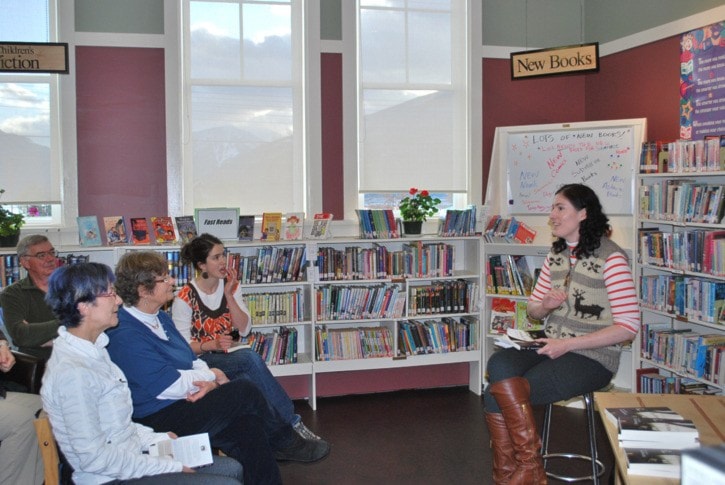Twenty-one people came to the Nakusp Library on a Friday afternoon in order to find out how a 29-year-old from New Westminster could conjure up the Kootenay mining camps of the 1940s and the Great On to Ottawa Trek and Winnipeg Riot of 1935.
Arley McNeney’s poetic masterpiece of a novel, The Time We All Went Marching, tells two interwoven stories. One narrative is about Edie, a woman on a train with her son Belly after leaving her husband, Slim, whom she last saw passed out drunk in their apartment with the windows open, and a snowflake on his face. The other story is Slim’s, and follows his experience a decade before with the On to Ottawa Trek of 1935, and its brutal conclusion in Winnipeg that same year.
The story was described by one reader as “a quilt of poems” because the chapters are short and carry titles that are as important as the paragraphs. Like a pattern on a quilt, the themes and storylines are intertwined, and each part contributes to the poignant beauty of the whole. Arley described how as part of the process of putting the book together, she actually laid the pieces of the story out on her living room floor and arranged them in different ways until they fit.
So, how can a 29-year-old from the Lower Mainland evoke so clearly the Kootenay mining camps of the 1940s? Because she grew up with these stories: her grandmother eloped when she was 17 with a man called Slim, and together they went and worked in the Kootenay mining camps. Years later, the grandmother, pregnant, took her firstborn son with her on a train back to New Westminster, leaving Slim passed out in an apartment. When Arley was a teenager, her grandmother wrote a 50-page memoir, which Arley read. A decade and some years later, after Arley wrote her first novel, Post, which was nominated for a Commonwealth Writer’s Prize (and is the only published novel about wheelchair basketball), she went off to the University of Illinois to study creative writing. There, surrounded by Illinois farmland populated by Americans, she decided to write a Canadian novel about the Kootenays in winter.
Arley desribed reading her grandmother’s memoir again after having finished writing the book and said that she was surprised to find that she had incorporated parts of stories that she didn’t even know were her grandmother’s: stories buried so deeply in her mind that they flowed into this book as her own. Unfortunately, her grandmother didn’t live to read this book, a tribute to her life, but the rest of Arley’s family did. Arley said she gets phone calls from family members asking if events in the story actually happened. It’s hard to really know: we read Arley inventing Edie’s story, who in turn invents parts of Slim’s stories, which he no doubt embellished, just as Arley heard her grandmother’s stories, who in turn invented parts of her Slim’s stories, which he no doubt embellished.
We readers are grateful to the writers and rememberers who embellish stories, weave them together into books, and make them their own. The Time We All Went Marching is available at the Nakusp Public Library, or for purchase from www.gooselane.ca.
